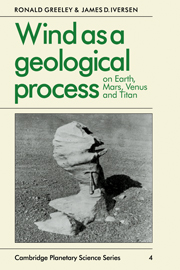Book contents
- Frontmatter
- Contents
- Preface
- 1 Wind as a geological process
- 2 The aeolian environment
- 3 Physics of particle motion
- 4 Aeolian abrasion and erosion
- 5 Aeolian sand deposits and bedforms
- 6 Interaction of wind and topography
- 7 Windblown dust
- Appendix A Nomenclature and symbols
- Appendix B Small-scale modeling of aeolian phenomena in the wind tunnel
- Glossary
- References
- Index
1 - Wind as a geological process
Published online by Cambridge University Press: 16 November 2009
- Frontmatter
- Contents
- Preface
- 1 Wind as a geological process
- 2 The aeolian environment
- 3 Physics of particle motion
- 4 Aeolian abrasion and erosion
- 5 Aeolian sand deposits and bedforms
- 6 Interaction of wind and topography
- 7 Windblown dust
- Appendix A Nomenclature and symbols
- Appendix B Small-scale modeling of aeolian phenomena in the wind tunnel
- Glossary
- References
- Index
Summary
Introduction
Beginning with the first tentative probes into space in the mid-1960s, the geological exploration of the solar system has revealed a remarkable diversity in the planets and their satellites. Each planetary body displays combinations of surface features that reflect unique geological histories and environments. Yet, when the surfaces of the terrestrial planets and satellites are analyzed in detail, we find that many of them have experienced similar geological processes in their evolution.
The discipline of comparative planetary geology has as its goal the definition of the fundamental processes that have shaped and modified the planets, satellites and other ‘solid surface’ bodies in the solar system. For simplification, we shall refer to all such objects simply as planets. The giant gaseous planets, such as Jupiter and Saturn, are excluded from study because they apparently lack solid surfaces and thus are not appropriate for geological analyses. The goal of planetary geology is achieved by determining the present state of planets, by deriving information of their past state(s) – or geological histories – and by comparing the planets to one another.
Comparative planetary geology has shown that nearly all of the planets have been subjected to major geological processes, including impact cratering, volcanism, tectonism (crustal deformation), and gradation. Gradation involves the weathering, erosion, and deposition of crustal materials through the actions of various agents, such as wind and water. This book deals with wind, or aeolian, processes (Fig. 1.1).
- Type
- Chapter
- Information
- Wind as a Geological ProcessOn Earth, Mars, Venus and Titan, pp. 1 - 32Publisher: Cambridge University PressPrint publication year: 1985
- 4
- Cited by



